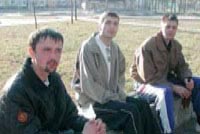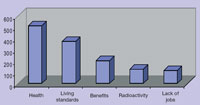Chernobyl Nuclear Accident
6. What are the current concerns and needs of affected people?
- 6.1 What worries people living in the affected regions?
- 6.2 What are the current needs of various affected groups?
6.1 What worries people living in the affected regions?
People living in the areas affected by the Chernobyl accident are uncertain about the impact of radiation on their health and surroundings, and do not know how to lead a healthy life in the region.
There are many misconceptions and myths about the threat of radiation that make residents feel powerless and unable to change their destinies. This has led both to excessively cautious behaviour linked to constant anxiety about health, and to reckless conduct such as eating forest products from areas of high contamination.
Therefore, Chernobyl-affected populations need clear, comprehensive, and unambiguous information about the accident and radiation, delivered in such a way that it overcomes the existing widespread mistrust.
Surveys show that the main worry of residents of the Chernobyl area is their own health and that of their children. However, they are also very concerned about socio-economic problems such as low household incomes and high unemployment. Therefore, the affected populations need measures that will help develop the region’s economy. More...
6.2 What are the current needs of various affected groups?

What are their needs?
Source: Chernobyl Forum
The people affected by the accident can be classified into three groups:
- The group requiring most help includes people who continue to live in severely contaminated areas and who are unable to support themselves adequately, resettlers who are unemployed, and people whose health is most directly threatened, for instance by thyroid cancer. These 100 000 to 200 000 people are caught in a downward spiral of isolation, poor health and poverty; and need substantial material help to rebuild their lives.
- The second group, numbering several hundreds of thousands of individuals, consists of those whose lives have been directly and significantly affected by the consequences of the accident but who are already in a position to support themselves. These people need help to reintegrate society as a whole and to normalise their lives as fully and as quickly as possible.
- The third group consists of several millions of people whose lives have been influenced by the accident mainly in that they have been labeled, or perceive themselves as victims of Chernobyl. These people need full, truthful and accurate information on the effects of the accident based on dependable and internationally recognised research. In addition, they need access to good quality health care, social services, and employment.
The approach of defining the most serious problems and addressing them with special measures, while pursuing an overall policy of promoting a return to normality, should apply to the affected territories as well as to the affected individuals and communities. Within the available budgets it is really the only alternative to the progressive breakdown of the recovery effort, continuing haemorrhaging of scarce resources and continuing distress for the people at the centre of the problem. More...




